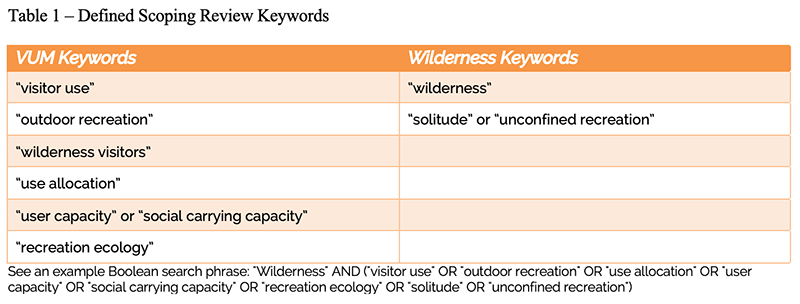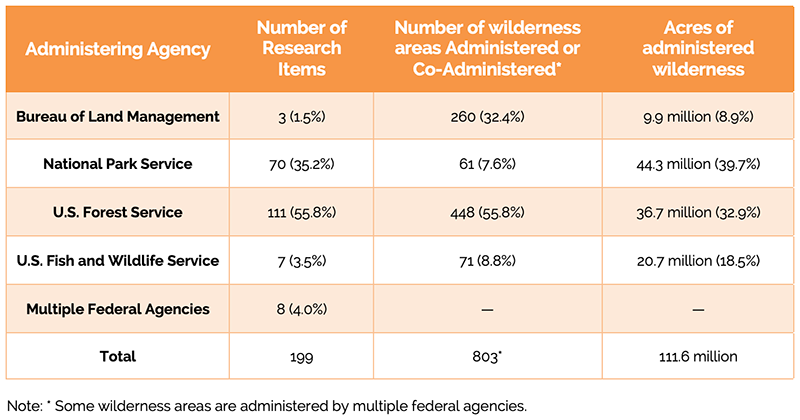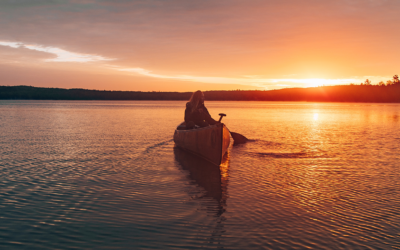The Mission Mountains (pictured) and Bob Marshall Wildernesses in northwest Montana were the focus of 10
VUM-focused research items published between 2000 and 2020. Photo credit Will Rice.
Distribution of Visitor Use Management Research in US Wilderness from 2000 to 2020: A Scoping Review
Communication & Education
December 2021 | Volume 27, Number 3
PEER REVIEWED
ABSTRACT
Visitor use in wilderness has grown over the past several decades, along with research focused on visitor use management (VUM) in congressionally designated wilderness. This scoping review of research published between 2000 and 2020 explores the distribution and representativeness of wilderness VUM research within the context of (a) the federal land management agencies administering wilderness and (b) the geographic distribution of research. Findings indicate wilderness administered by the Bureau of Land Management and US Fish and Wildlife Service were disproportionately understudied compared to both the total acreage of wilderness and number of wilderness areas administered by the US Forest Service and National Park Service. Additionally, large geographic gaps exist in the research produced during this period, with clusters of VUM-related research occurring in high-profile wilderness areas and the vast majority (89%) of wilderness areas generating no research. As we look toward the next 20 years of wilderness VUM-related research, these findings suggest a need for a more representative narrative and highlight several specific opportunities for future research.
Wilderness visitor use management (VUM) research has evolved and expanded since the creation of the National Wilderness Preservation System (NWPS) in 1964 (Cole and Williams 2012). Initially concerned with exploring fundamental questions about visitor motivations (Cole 2011; Cole and Williams 2012), VUM research in federally designated wilderness has evolved to “more deeply explore [the] visitor experience as the thoughts, emotions, and physical feelings that arise from visitors’ activities, their physical and social context, and their focus of attention” (Cole 2011, 68). Beyond evolving explorations of the visitor, wilderness VUM research has also changed with management needs and philosophies, the changing composition of the NWPS, and an increased capability to conduct research. For instance, educating visitors through the Leave No Trace program gained support as a complement to regulating amounts of use under early carrying capacity approaches (Cole 2018). More broadly, social science efforts in wilderness VUM were guided by various policy changes such as the congressional introduction of the Recreation Fee Demonstration Program (Watson et al. 2015). Administratively, the original Wilderness Act only designated US Forest Service areas, mostly in the West, and, over time, designations included other federal land management agencies (e.g., the National Park Service), geographic regions, and ecosystem types (Watson and Armatas 2018). As wilderness designations expanded, research needs did as well, as reflected in the establishment of the Aldo Leopold Wilderness Research Institute (ALWRI) in 1993 (Cole 2019). The ALWRI is a federal interagency science unit based in Montana, which is charged with conducting and sharing research to support all federal land management agencies administering the NWPS. However, the formal interagency focus of wilderness research, led by the ALWRI, emerged after nearly 30 years of research conducted by the Intermountain Research Station’s Wilderness Management Research Work unit (a US Forest Service unit established in 1967 in Montana).
“…face-to-face communication has quickly become a secondary option due to the overwhelming preference, and ease, of digital exchange. Although the ability to remotely communicate and share information with friends, family, and colleagues serves as an incredible tool – culturally, there has been less dialogue toward determining the appropriate use of our novel communication technologies.”
From 1987 to 2012, numerous reviews were conducted on wilderness VUM research (Cole 2001; Cole 2011; Cole and Williams 2012; Hollenhorst et al. 1992; Freimund and Cole 2001; Leung and Marion 2000; Krumpe 2000; Roggenbuck and Lucas 1987). However, these reviews largely consisted of selective, or nonscoping/systematic, research (see Cole 2011). Roggenbuck and Lucas (1987) provided a unique systematic review of wilderness research related to VUM, which included a descriptive analysis of where research was being conducted; the authors found research focused on a very small fraction of all wilderness areas (e.g., Bob Marshall Wilderness Complex and Boundary Waters Canoe Area Wilderness) administered almost exclusively by one agency (US Forest Service). As wilderness VUM research continues within the context of a NWPS that is now geographically diverse and managed by all four major federal land management agencies, there is a need to understand the more recent distribution of VUM research to ensure diverse representation of geographies, use patterns, and management in the greater wilderness VUM research narrative.
In general, limited empirical research has examined the NWPS as a whole (Watson and Armatas 2018). To our knowledge, no study in the past 20 years has empirically assessed VUM research across the NWPS as it relates to geographic focus and administering federal agency. Therefore, the purpose of this study is to examine recent spatial and agency disparities in VUM research throughout the NWPS. Importantly, this study is not a “state-of-the-knowledge review” and does not include analysis of research themes, increases in wilderness designation, or VUM research, more broadly. Instead, this study seeks to provide a first step toward a larger review of VUM research within the NWPS by addressing more recent spatial and agency research disparities, exclusively. Through a scoping review and spatial descriptive analysis, we examine these disparities in the wilderness VUM-related research items published from 2000 to 2020. In doing so, we identify agencies, regions, and wilderness areas that have been disproportionately understudied over this period. We define disparities not in relation to visitation volume across wilderness areas or agencies, nor in relation to the national profiles of particular wilderness areas or agencies. Instead, we examine disparities related to (1) distributions across space and (2) in relation to the total area and number of wilderness areas administered by each agency. Previous research clearly illustrates the importance of studying visitor use regardless of use levels (Freimund and Cole 2001; Graefe et al. 2011); as demonstrated by D’Antonio and Monz (2016), low visitation conditions can potentially lead to more resource impacts than high visitation conditions. It is important to identify understudied sites, as they may represent areas where important visitor use phenomena are happening, but are not influencing the larger, national research narrative surrounding wilderness VUM. Further, tracking changes and trends in wilderness character – an important task of wilderness stewards on the ground—is complicated by a lack of a baseline understanding of visitors in the vast majority of wilderness areas. With these realities in mind, management and policy decisions – lacking representative research – may be based on only a subset of geographically and administratively similar wilderness areas. Therefore, the following two research questions guide this study:
R1: What is the recent distribution of wilderness VUM-related research (2000–2020) across administering agencies, and what agencies are disproportionately understudied?
R2: What is the geographic distribution of recent wilderness VUM-related research (2000–2020) across the NWPS, and what geographic areas containing wilderness are disproportionately understudied?
Methods
This study takes the form of a scoping review (see Arksey and O’Malley 2005). Scoping reviews are “commonly undertaken to examine the extent, range, and nature of research activity in a topic area” (Pham et al. 2014, 371). This reviewing approach is unique from a systematic review, as it does not engage in meta-analysis or include an assessment of research quality (Hanneke et al. 2017). Scoping reviews are useful in assessing the general “landscape” of an area of research (Hanneke et al. 2017). This study relies on Arksey and O’Malley’s (2005) methodological framework for scoping studies, with additional guidance from Levac et al.’s (2010) update to this framework and its five-step review process: identify the research question, identify relevant studies, select studies, chart the data, and summarize results.
Research items were gathered from four databases: Google Scholar, USDA Treesearch, Aldo Leopold Wilderness Research Institute publication database, and ProQuest Dissertations & Theses database. Additionally, targeted searches were conducted within four outdoor recreation-related journals: International Journal of Wilderness, Journal of Park and Recreation Administration, Journal of Outdoor Recreation and Tourism, and Journal of Leisure Research. Searches of databases and journals used the same Boolean-based keyword inquiries (see table 1). Research items were screened using predetermined inclusion criteria, including: published between January 2000 and September 2020, published in the English language, focused on VUM in US federally designated wilderness, and not published as commentary, editorial, or conference abstract. For the purposes of our review, VUM was defined using the definition established by the Interagency Visitor Use Management Council (2016): “The proactive and adaptive process for managing characteristics of visitor use and the natural and managerial setting using a variety of strategies and tools to achieve and maintain desired resource conditions and visitor experiences” (113). Given the applied nature of wilderness VUM-related research, peer-review was not an inclusion criterion – as many studies are published only in general technical reports, theses, or dissertations.
Each research item meeting the inclusion criteria was coded according to the wilderness area that served as its primary research setting. Additionally, the encompassing state/states and administering agency/agencies for each wilderness area were recorded in a common spreadsheet. Counts of research items falling within each wilderness area, state, and agency jurisdiction were then generated. Counts for each wilderness area and state were subsequently geocoded using ArcGIS Pro. Through a final step of analysis, the number of research items per state was divided by the total number of wilderness areas per state to obtain a coefficient, or ratio, of representation.
Results
In total, 259 research items focused on VUM research within the NWPS were identified through the scoping review process that met the inclusion criteria. Of these, 199 items focused on a specific wilderness, or selection of wilderness areas. Sixty items met the inclusion criteria but were not specific to a single wilderness area or a set of wilderness areas (e.g., review papers and conceptual pieces). These items were therefore excluded from this analysis. Of the 199 remaining items, 111 (55.8%) examined 1 or more units of US Forest Service–administered wilderness, and 70 (35.2%) examined National Park Service–administered wilderness (see table 2). Wilderness administered by the US Fish and Wildlife Service and Bureau of Land Management was the focus of just 7 (3.5%) and 3 (1.5%) items, respectively. Per both the number of wilderness areas administered and the total amount of wilderness acreage administered, the US Fish and Wildlife Service and Bureau of Land Management are underrepresented in these research items (see figure 1).
In terms of geographic distribution, of the 44 states containing wilderness, 16 states had no VUM-related research (zero research items) published from 2000 to 2020 (Figure 2). This group of states includes New Mexico, which presently contains 39 wilderness areas. Additionally, Nevada, which contains 70 wilderness areas, produced only 1 research item. On average, states contained 0.33 research items per wilderness area (e.g., 3 total research items across 9 wilderness areas within the state). The states with a ratio of research items to wilderness areas greater or equal to 1 include Indiana, Kentucky, Minnesota, New Hampshire, and Pennsylvania. Of those states containing at least 5 wilderness areas, Alaska, Montana, New Hampshire, and South Carolina have a research item to wilderness ratio greater than or equal to 0.5 (see figure 2).
In figure 3, disparities within states become apparent. For instance, in Michigan and Minnesota, we find all of these states’ research items, 7 and 9 respectively, clustered in the Isle Royale and Boundary Waters Canoe Area Wilderness areas – leaving the remainder of the states’ wilderness areas with 0 research items. Similarly, in Virginia, all research items focus on the Shenandoah Wilderness – leaving 23 wilderness areas without any VUM research. In Oregon, we find the majority of studies clustered along the wilderness areas within the Cascade Range, with wilderness areas along the Pacific Coast and in the eastern desert disproportionately understudied. The lack of research items focused on coastal wilderness is strikingly illustrated in figure 3. Only one wilderness on the Atlantic Coast, Cumberland Island, generated a research item. Wilderness areas along the Gulf of Mexico include 0 items, while those in California, Oregon, and Washington bordering the Pacific Ocean have but 1 area – King Range Wilderness – that generated research items. A variety of regions containing numerous wilderness areas appear similarly underrepresented, including Vermont’s Green Mountains, the Ozarks of Missouri and Arkansas, the Great Basin of Nevada and Utah, the Everglades and Keys of South Florida, and the Great Plains.
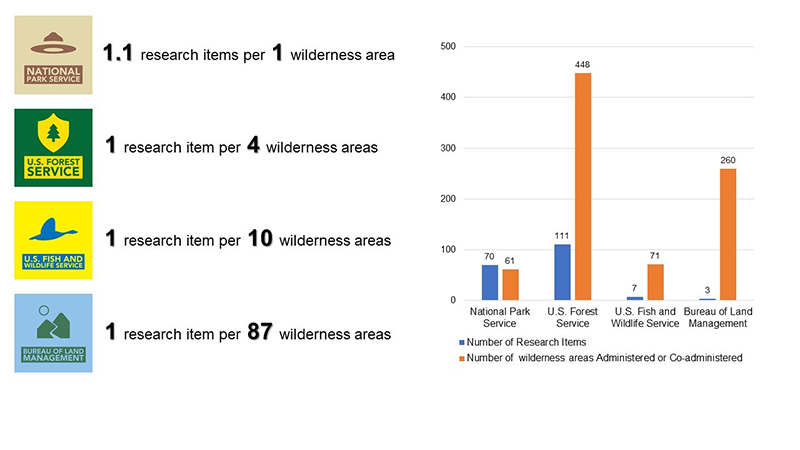
Figure 1 – Ratio of number of research items per wilderness areas administered by the four federal agencies administering wilderness.
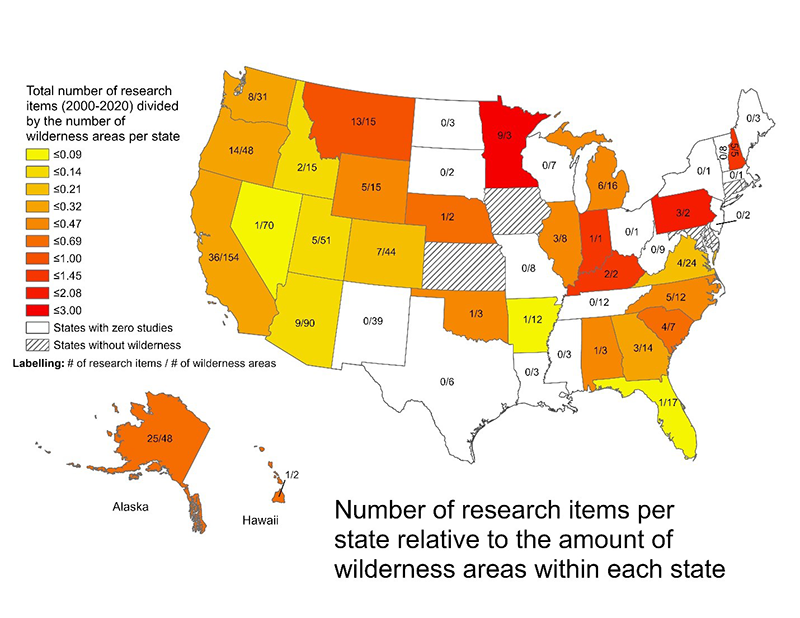
Figure 2 – Number of research items per state relative to the amount of wilderness areas within each state.
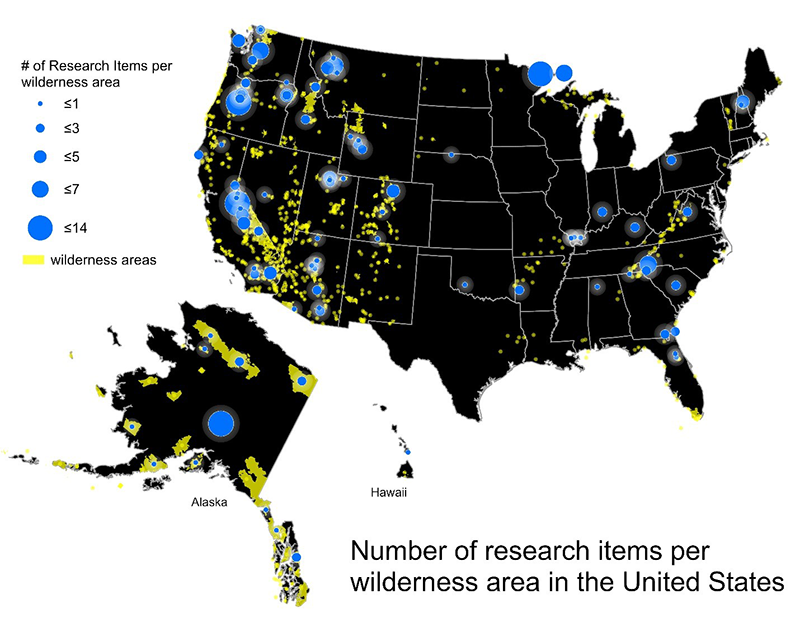
Figure 3 – Number of research items per state relative to the amount of wilderness areas within each state.
Discussion
Agency Distribution
From an agency perspective, the largest disparity revealed through this study is the lack of VUM-related research focused on Bureau of Land Management– and U.S. Fish and Wildlife Service–administered wilderness. The Bureau of Land Management administers 32.4% of all wilderness areas, but accounts for just 1.5% of all recent research items. This represents a continuation of a long-running trend. Roggenbuck and Lucas (1987) note, “Past research on use and users has focused primarily on National Forest wilderness, with limited coverage of National Park areas,” and, “There have been virtually no published studies on [US] Fish and Wildlife Service and Bureau of Land Management–managed “wilderness” (237). The authors note just three research items including National Park Service-administered wilderness (Gilbert 1980; Hendee et al. 1978; van Wagtendonk and Benedict 1980). In their nonsystematic review of wilderness recreation ecology research, Leung and Marion (2000) find a similar pattern, reporting that most of the research to date was conducted in US Forest Service–administered wilderness, with some research occurring in National Park Service–administered wilderness, and very limited research occurring in Bureau of Land Management– and US Fish and Wildlife Service–administered wilderness. While National Park Service–administered wilderness has received increased research since the Roggenbuck and Lucas (1987) review – evidenced by being the focus of 35.2% of all research items between 2000 and 2020 – the other agencies remain largely underrepresented.
Agency missions provide one potential reason for the disparity of recent research among agencies. For instance, historically, outdoor recreation was less central to the mission of the Bureau of Land Management (Glicksman 2014). Additionally, the work of the specially designated institutes, centers, and divisions within the US Forest Service and National Park Service likely impact the amount of wilderness VUM research within these two agencies. However, with relatively recent structural changes occurring within recreation management of federal agencies (e.g., the restructuring of the Bureau of Land Management, designation of Urban National Wildlife Refuges, shifting management of cultural resources in wilderness, etc.) this prioritization may shift. For instance, the creation of the Bureau of Land Management’s National Landscape Conservation System may well make wilderness VUM a greater priority given the system’s focus on offering “unparalleled recreational opportunities” (Jarvis 2003, 110).
The disparity in agency priorities has several important implications related to varying resources, missions, and recreation patterns across agencies. First, the nature of the resources preserved by wilderness tends to vary across agencies (Glicksman 2014). Each agency has a unique mission and history; they manage lands protected for various reasons, and the environments of those protected lands vary by agency. The Bureau of Land Management, for example, is the product of those “leftover” lands of the US federal government’s defunct General Land Office (Glicksman 2014). These lands are somewhat distinct in their physical characteristics from those, for example, that are administered by the National Park Service and were largely selected from the public domain for their outstanding qualities. For instance, the National Park Service–administered Joshua Tree Wilderness was the focus of four research items during the study period, while its five adjacent Bureau of Land Management–administered wilderness areas generated zero research items, combined. Second, despite a common wilderness mandate, agencies tend to manage wilderness differently (Zellmer 2014). For example, Glicksman (2014) examines differences in wilderness management between the Bureau of Land Management and the US Forest Service – both “multiple-use” oriented agencies –finding that divergences arise from agency culture, policy, judicial treatment, and varying physical characteristics in the two agencies’ lands.
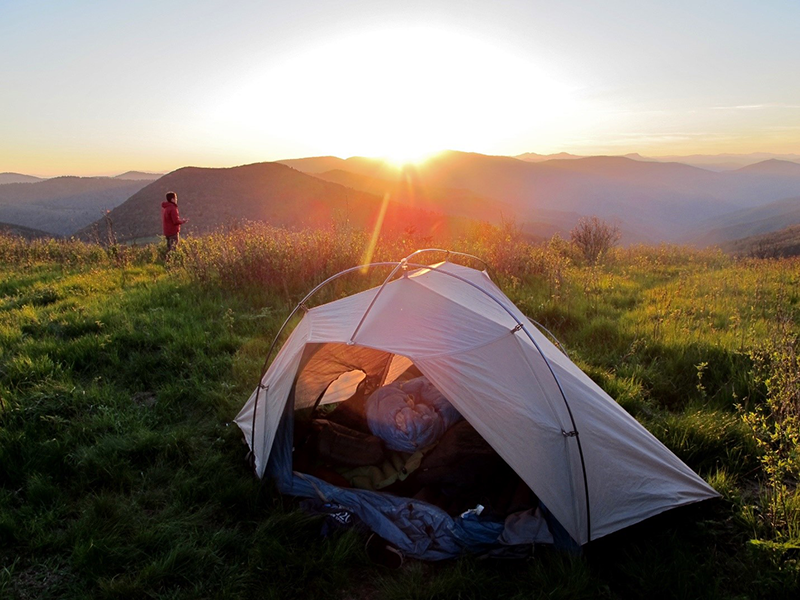
Figure 4 – North Carolina’s Shining Rock Wilderness generated the most VUM-related research items among the wilderness areas of the eastern United States from 2000 to 2020. Photo by Will Rice.
Finally, wilderness users and recreation patterns vary across agencies, largely in response to physical characteristics and agency missions (Zellmer 2014). As Zellmer (2014) notes, wilderness managers in the National Park Service face increased pressure from tourism, while their counterparts in the US Fish and Wildlife Service must navigate unique visitor use impacts related to wildlife-focused mandates and hunting in wilderness. The latter agency prioritizes wildlife-related activities “such as environmental education, interpretation, wildlife photography, hunting, and fishing” while “nonwildlife-related recreation receives a lower priority ranking” (Zellmer 2014, 523). This is not the case in the National Park Service (Zellmer 2014). Therefore, certain visitors and uses are likely being overlooked through VUM research almost exclusively concentrated on wilderness administered by the US Forest Service and National Park Service.
Geographic Distribution
In their review of the literature in 1987, Roggenbuck and Lucas note, “Relatively few studies have been conducted in the East and California,” and, “The Desert Southwest and the South are little studied.” (206). Our results show that – more recently – California hosted the most research items per state over the past 20 years, addressing this previous disparity. However, much of the East, including New England and Florida, is still underrepresented in wilderness VUM research (research items to wilderness areas ratios < .33). The same could be said for the southern group of states ranging west to east from New Mexico to Florida. Roggenbuck and Lucas (1987) also note that only 7.4% (33 out of 442) wilderness areas had been studied within the realm of VUM by 1985. Our results show 11.5% (92 out of 803) wilderness areas were the subject of wilderness VUM research from 2000 to 2020. Therefore, while some regions and agencies remain disproportionately understudied, the group of wilderness areas hosting VUM research appears to be diversifying to some degree. It is important to note, however, that much has changed in the wilderness VUM research realm since the review by Roggenbuck and Lucas (1987). The number of units within the NWPS nearly doubled. Additionally, the ALWRI was established in 1993, likely aiding expansion of wilderness VUM research.
The primary outcome of the inconsistent coverage of VUM research across the NWPS is an overall research narrative that remains nonrepresentative of the larger system. Large, well-researched sites such as Yosemite, Denali, Boundary Waters Canoe Area, Three Sisters, and Rocky Mountain National Park Wilderness Areas generate numerous research items, while the vast majority of the system (89%) generates zero VUM research. Therefore, our understandings of wilderness visitors’ recreational impacts, motivations, values, encounter norms, and Leave No Trace competencies are derived from only those recreationists who visit the 11% of the system that generates VUM-related research. However, visitor characteristics, travel patterns, and encounter norms vary across wilderness areas (Ewert and Hood 1995). Importantly, Lindley et al. (2018) note that the urban-proximate wilderness experience is somewhat distinct from the nonurban proximate experience (e.g., less sensitivity to crowding). Yet throughout two decades of wilderness management that sought to increase relevance and inclusion, zero VUM research items were produced in wilderness areas immediately adjacent to the New York, Miami, Las Vegas, Portland, or San Francisco metro areas.
Further Implications of Nonrepresentative Distributions of Research
When it comes to VUM-related research allocation, we posit that perhaps an implicit hierarchy exists, as some agencies and areas receive more research. Possibly as a result of the evolution of wilderness research, agency priorities, funding, and missions, lasting research traditions at a unit level, and, perhaps, researcher preferences, many high-use wilderness areas have never or scarcely been studied in the context of VUM (e.g., Gila, La Madre Mountain, Marjory Stoneman Douglas, Otis Pike Fire Island High Dune Wilderness Areas), while others generate research items on a nearly biennial basis (e.g., Yosemite, Three Sisters, Denali, and Boundary Waters Canoe Area Wilderness areas). While the focus of wilderness VUM-related research items between 2000 and 2020 shows relatively greater coverage of the NWPS compared to the review by Roggenbuck and Lucas (1987), the more recent cohort of studies still represents just over 11% of the system. As a result, the knowledge created from wilderness VUM research, which may be influencing managers throughout the NWPS, is based on a small portion of the system. While trends data from well-studied wilderness areas are important, it is also important to recognize the opportunity cost of focusing on such a small portion of the larger NWPS. As noted by Roggenbuck and Lucas (1987), a continued focus on the same set of wilderness areas – the majority being “mountainous and alpine” – comes at a cost, in the form of a knowledge gap concerning the “study [of] wilderness use and users in desert, swamp, and coastal plain wildernesses” (237). It is therefore important to recognize that wilderness areas are not created equal, and that essentially all wilderness areas – despite the primary reasons for their designation – host some level of visitor use (with the exception of very remote areas), and each one has unique visitation patterns and uses and is worthy of study.
An Agenda for Future Research
Given the findings of this study, we highlight opportunities for future wilderness VUM research, which may support addressing geographic and agency disparities. We do not recommend halting the collection of long-term trend data, but instead suggest the pursuit of additional research in those areas, environments, and agencies that have received less attention throughout the previous two decades. It is imperative that underrepresented wilderness areas be studied to generate a more complete understanding of visitor use throughout the NWPS. We acknowledge that visitation volume is not the only justification for VUM research (Freimund and Cole 2001; Graefe et al. 2011). Environments have varying levels of sensitivity to wilderness recreation (Marion et al. 2016), visitors’ sensitivity to crowding and other aspects of the social and managerial setting vary across wilderness areas (Cole 2001), and wilderness management varies across agencies (Glicksman 2014; Zellmer 2014). Given previous demonstrations for how the ecological and social settings impact wilderness visitor use, targeted studies must attempt to amend regional disparities in research by focusing on wilderness areas in the Gulf, Atlantic and Pacific Coasts, Great Plains, Great Basin, and Ozarks. Additionally, we stress the importance of research in oft-overlooked urban-proximate wilderness areas, as future projections suggest continued increase of wilderness day use by urban residents (Cole and Hall 2010). Finally, we highlight the potential value of prioritizing VUM research in Bureau of Land Management and US Fish and Wildlife Service–administered wilderness to examine unique qualities of VUM in these wilderness areas and provide a more comprehensive narrative concerning visitor use throughout the NWPS.

Figure 5 – Of wilderness areas generating VUM research between 2000 and 2020, California’s King Range Wilderness is both the only wilderness area along the US contiguous Pacific Coast and the only wilderness area administered by the Bureau of Land Management. Photo by Bob Wick/Bureau of Land Management.
Conclusion
Recent wilderness VUM research occurring between 2000 and 2020 was not representative of the areas within the NWPS or the agencies that administer it. Bureau of Land Management– and US Fish and Wildlife Service–administered wilderness were disproportionately understudied compared to both the total acreage of wilderness and number of wilderness areas administered by the agencies. Additionally, large geographic gaps exist in the research produced during this period, with dense clusters of VUM-related research occurring in high-profile wilderness areas, and the vast majority (89%) of wilderness areas generating no research. As a result, the research narrative concerning VUM in wilderness is derived from only those recreationists who visit the 11% of the system that generates VUM-related research. These findings suggest a need for the wilderness VUM research community to pursue a more representative narrative concerning spatial and agency distribution. As we look toward the next 20 years of wilderness VUM research, we recognize the agency and geographic disparities of the previous 20 years and note the great value in conducting research that was representative across settings and agencies. With Thoreau in mind, we remember that “the future” of wilderness is perhaps not found in the long-studied alpine gardens “but in the impervious and quaking swamps” (2013, 262).
Acknowledgments
We acknowledge funding support for this research from the National Park Service Park Planning and Special Studies, and technical assistance from the Wilderness Stewardship Division and Denver Service Center (Interagency Agreement 17-IA-11221639-144), and the Research Joint Venture (20-JV-11221639-162) between the University of Montana and the Aldo Leopold Wilderness Research Institute.
About the Authors
WILLIAM L. RICE is an assistant professor of outdoor recreation and wildland management at the University of Montana in the Parks, Tourism, and Recreation Management program: william.rice@umontana.edu.
CHRISTOPHER A. ARMATAS is a research social scientist with the Aldo Leopold Wilderness Research Institute, USDA Forest Service; email: christopher.armatas@usda.gov.
JENNIFER M. THOMSEN is an associate professor at the University of Montana in the Parks, Tourism, and Recreation Management program; email: jennifer.thomsen@umontana.edu.
JACLYN R. RUSHING is a PhD student at the University of Montana in the Department of Society and Conservation; email: jaclyn.rushing@umontana.edu.
References
Arksey, H., and L. O’Malley. 2005. Scoping studies: Towards a methodological framework. International Journal of Social Research Methodology: Theory and Practice 8(1): 19–32.
Cole, D. N. 2001. Visitor use density and wilderness experiences: A historical review of research. In Visitor Use Density and Wilderness Experience: Proceedings; 2000 June 1–3; Missoula, MT, ed. W. A. Freimund and D. N. Cole (pp. 11–20). Proc. RMRS-P-20. Ogden, UT: US Department of Agriculture, Forest Service, Rocky Mountain Research Station.
Cole, D. N. 2011. Wilderness visitor experiences: A selective review of 50 years of research. Park Science 28(3): 66–70.
Cole, D. N. 2018. Leave No Trace: How it came to be. International Journal of Wilderness 24(3): 54–65.
Cole, D. N. 2019. Pioneers of wilderness research: The Wilderness Management Research Unit. International Journal of Wilderness 25(1): 42–60.
Cole, D. N., and T. E. Hall. 2010. Privacy functions and wilderness recreation: Use density and length of stay effects on experience. Ecopsychology 2(2): 75.
Cole, D. N., and D. R. Williams. 2012. Wilderness visitor experiences: Progress in research and management. In Wilderness Visitor Experiences: Progress in Research and Management, ed. D. N. Cole (pp. 3–20). Fort Collins, CO: US Department of Agriculture, Forest Service, Rocky Mountain Research Station.
D’Antonio, A., and C. Monz. 2016. The influence of visitor use levels on visitor spatial behavior in off-trail areas of dispersed recreation use. Journal of Environmental Management 170: 79–87.
Ewert, A. W., and D. Hood. 1995. Urban-proximate and urban-distant wilderness: An exploratory comparison between two “types” of wilderness. Journal of Park and Recreation Administration 13(2): 73–85.
Freimund, W. A., and D. N. Cole. 2001. Use density, visitor experience, and limiting recreational use in wilderness: Progress to date and research needs. In Visitor Use Density and Wilderness Experience: Proceedings; 2000 June 1–3; Missoula, MT, ed. W. A. Freimund and D. N. Cole (pp. 3–8). Proc. RMRS-P-20. Ogden, UT: US Department of Agriculture, Forest Service, Rocky Mountain Research Station.
Gilbert, R. S. 1980. Dispersed winter recreation use in the Badger Pass backcountry of Yosemite National Park: Challenges and opportunities. In Proceedings, North American Symposium on Dispersed Winter Recreation; 1980 February 27–29 (pp. 114–117). St. Paul: University of Minnesota, Agricultural Extension Service.
Glicksman, R. L. 2014. Wilderness management by the multiple use agencies: What makes the Forest Service and the Bureau of Land Management different? Environmental Law 44(447): 448–495.
Graefe, A. R., K. Cahill, and J. Bacon. 2011. Putting visitor capacity in perspective: A response to the Capacity Work Group. Journal of Park and Recreation Administration 29(1): 21–37.
Hanneke, R., Y. Asada, L. Lieberman, L. C. Neubauer, and M. Fagen. 2017. The scoping review method: Mapping the literature in “structural change” public health interventions. In SAGE Research Methods Cases. Thousand Oaks, CA: SAGE.
Hendee, J. C., G. H. Stankey, and R. C. Lucas. 1978. Wilderness Management: Miscellaneous Publication No. 1365. Washington, DC: US Department of Agriculture, Forest Service.
Hollenhorst, S. J., S. A. Whisman, and A. W. Ewert. 1992. Monitoring Visitor Use in Backcountry and Wilderness: A Review of Methods. Albany, CA: US Department of Agriculture, Forest Service, Pacific Southwest Research Station.
Interagency Visitor Use Management Council. 2016. Visitor Use Management Framework: A Guide to Providing Sustainable Outdoor Recreation. Washington, DC: Interagency Visitor Use Management Council.
Jarvis, J. 2003. National Landscape Conservation System: A new approach to conservation. In Science and Stewardship to Protect and Sustain Wilderness Values: Seventh World Wilderness Congress Symposium; 2001 November 2–8; Port Elizabeth, South Africa, ed. A. Watson and J. Sproull (pp. 110–113), Proc. RMRS-P-27. US Department of Agriculture, Forest Service, Rocky Mountain Research Station.
Krumpe, E. E. 2000. The role of science in wilderness planning – a state-of-knowledge review. In Wilderness Science in a Time of Change Conference – Volume 4: Wilderness Visitors, Experiences, and Visitor Management, ed. D. N. Cole, S. F. McCool, W. T. Borrie, and J. O’Loughlin (pp. 5–12). Ogden, UT: US Department of Agriculture, Forest Service, Rocky Mountain Research Station.
Leung, Y., and J. L. Marion. 2000. Recreation impacts and management in Wilderness: A state-of-knowledge review. In Wilderness Science in a Time of Change Conference – Volume 5: Wilderness Ecosystems, Threats, and Management; 1999 May 23–27; Missoula, MT, ed. D. N. Cole, S. F. McCool, W. T. Borrie, and J. O’Loughlin (pp. 23–48). Proc. RMRS-P-15-VOL-5. Ogden, UT: US Department of Agriculture, Forest Service, Rocky Mountain Research Station.
Levac, D., H. Colquhoun, and K. K. O’Brien. 2010. Scoping studies: Advancing the methodology. Implementation Science 5(1): 69.
Lindley, B. R., M. D. Blevins, and S. D. Williams. 2018. Cultural meanings and management challenges: High use in urban-proximate wilderness. International Journal of Wilderness 24(3): 16–25.
Marion, J. L., Y.-F. Leung, H. Eagleston, and K. Burroughs. 2016. A review and synthesis of recreation ecology research findings on visitor impacts to wilderness and protected natural areas. Journal of Forestry 114(3): 352–362. https://doi.org/10.5849/jof.15-498.
Pham, M. T., A. Rajić, J. D. Greig, J. M. Sargeant, A. Papadopoulos, and S. A. McEwen. 2014. A scoping review of scoping reviews: Advancing the approach and enhancing the consistency. Research Synthesis Methods 5(4): 371–385.
Roggenbuck, J. W., and R. C. Lucas. 1987. Wilderness use and user characteristics: A state-of-knowledge review. In Proceedings, National Wilderness Research Conference: Issues, State-of-Knowledge, Future Directions, Fort Collins, CO, July 23–26, 1985, ed. R. C. Lucas (pp. 204–245). US Dept. of Agriculture, Forest Service, Intermountain Research Station.
Thoreau, H. D. 2013. Walking. In Essays: A Fully Annotated Edition, ed. J. S. Cramer (pp. 243–280). New Haven, CT: Yale University Press.
van Wagtendonk, J. W., and J. M. Benedict. 1980. Wilderness permit compliance and validity. Journal of Forestry 78(7): 399–401.
Watson, A. E., and C. A. Armatas. 2018. A mental model of science informed by public land managers: Increasing the chances for management based on science. Journal of Contemporary Management 8(4): 1–17.
Watson, A. E., H. K. Cordell, R. Manning, and S. Martin. 2015. The evolution of wilderness social science and future research to protect experiences, resources, and societal benefits. Journal of Forestry 114(3): 329–338.
Zellmer, S. B. 2014. Wilderness management in national parks and wildlife refuges. Environmental Law 44: 497–548.
Read Next
December 2021
In this issue of IJW, we remember George Stankey and his contributions to wilderness research and stewardship. Mark Anderson provides a synthesis of recent findings on carbon storage in old growth forests. Rosemary Evans examines prescribed burning in Britain’s moorlands. And Tobias Nickel presents a call for a standard definition of “Natural” in wilderness stewardship.
Crises of Use
As we transition to a post-pandemic society, demand for transformational, restorative, and education experiences in nature will not recede. Nature has demonstrated its diverse benefits to a greater constituency these past months, and we as advocates, scientists, and managers need to embrace the challenge that comes with a larger audience.
George Stankey: Mentor, Colleague, Friend
George Stankey was a critical thinker who saw the big picture and could work across disciplinary boundaries.

